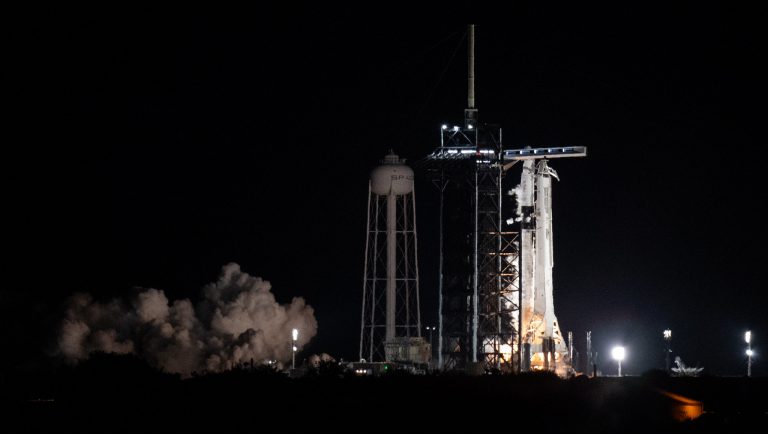SpaceX fires up Falcon 9 rocket for Crew-3 Halloween astronaut launch
The Crew-3 mission is scheduled to lift off early Sunday morning (Oct. 31).

CAPE CANAVERAL, Fla. — SpaceX has fired up the rocket that will launch its next crew of astronauts toward the International Space Station this weekend.
The private spaceflight company conducted a static-fire test before dawn Thursday (Oct. 28) of its Falcon 9 rocket at Pad 39A here at NASA's Kennedy Space Center. The test is one of the last major milestones ahead of a planned launch on Sunday (Oct. 31).
That launch will kick off Crew-3, SpaceX's third operational crewed mission to the International Space Station for NASA. Crew-3 will send three NASA astronauts and one German spaceflyer to the orbiting lab.
Live Updates: SpaceX's Crew-3 astronaut mission
Today's static fire — a routine test that ensures a rocket is ready to fly — occurred as expected in the predawn hours. Smoke and fire billowed briefly as the Falcon 9's nine first-stage Merlin 1D engines were lit while the rocket remained anchored to the pad.
Shortly afterward, SpaceX tweeted that the static fire was a success and that the company will be moving forward with its planned Halloween launch.
Crew-3 is set to blast off at 2:21 a.m. EDT (0621 GMT) on Oct. 31, sending a Crew Dragon capsule named Endurance skyward. Following a successful liftoff, the Falcon 9's first stage is expected to land on one of SpaceX's drone ships, called Just Read the Instructions. If all goes as planned, Endurance will spend just under 24 hours trailing the space station before arriving at the orbital outpost early Monday (Nov. 1).
Get the Space.com Newsletter
Breaking space news, the latest updates on rocket launches, skywatching events and more!

Endurance is brand-new, but it sits atop a previously flown rocket: This Falcon 9's first stage also launched a robotic cargo mission to the space station in June.
The Falcon 9 and Endurance were rolled out of their hangar and onto the launch pad at Complex 39A on Wednesday morning (Oct. 27). Standing 215 feet (65 meters) tall, the pair was lifted upright later that afternoon.
Secured to the launch pad, teams worked overnight to prep the rocket for its static fire test. They loaded the rocket with super-chilled propellants — kerosene and liquid oxygen.
The nine first-stage engines briefly fired at 1 a.m. EDT (0500 GMT) Thursday, generating 1.7 million pounds of thrust while the booster remained firmly on the ground. Engineers reviewed the data before confirming that they would proceed with a launch on Sunday.
The static fire test comes on the heels of a flight readiness review, which cleared the mission for flight on Monday evening (Oct. 25), and the crew's arrival in Florida. Raja Chari, Tom Marshburn, and Kayla Barron of NASA were joined by the European Space Agency's Matthias Maurer as they arrived at Kennedy Space Center on Tuesday afternoon (Oct. 26).
Up next is a full dress rehearsal for the crew. Currently, forecasters at the 45th Space Delta here at Cape Canaveral Space Force Station predict an 80% chance of favorable conditions for liftoff on Sunday morning. The only cause for concern is a slight chance of flight through precipitation.
Follow Amy Thompson on Twitter @astrogingersnap. Follow us on Twitter @Spacedotcom or Facebook.
Join our Space Forums to keep talking space on the latest missions, night sky and more! And if you have a news tip, correction or comment, let us know at: community@space.com.

Amy Thompson is a Florida-based space and science journalist, who joined Space.com as a contributing writer in 2015. She's passionate about all things space and is a huge science and science-fiction geek. Star Wars is her favorite fandom, with that sassy little droid, R2D2 being her favorite. She studied science at the University of Florida, earning a degree in microbiology. Her work has also been published in Newsweek, VICE, Smithsonian, and many more. Now she chases rockets, writing about launches, commercial space, space station science, and everything in between.









